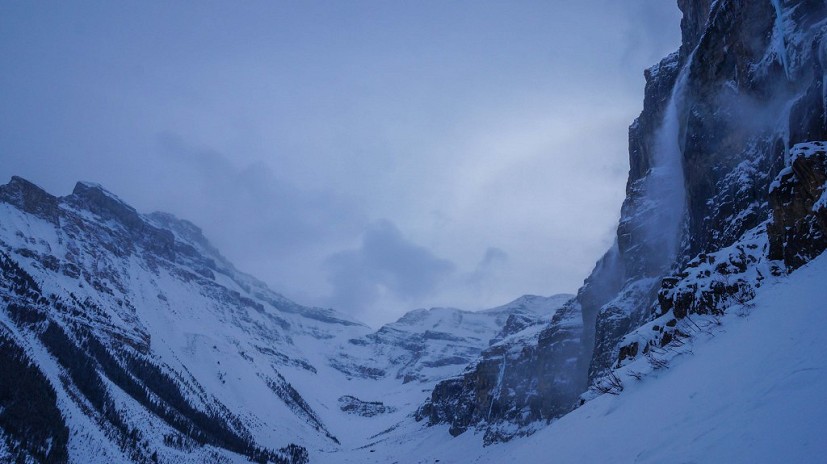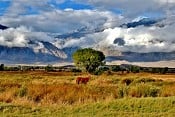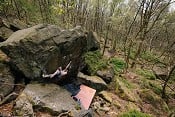
The Canadian Rockies have long held the reputation as the destination for ice climbers, and for good reason. With many lifetimes worth of classic routes to go at in a beautiful, friendly and easily accessible setting, the draw is obvious. Add to this the guarantee of good conditions and it is easy to see why so many winter warriors continue to make the long flight.
The beauty of climbing in Canada in winter is that whatever you are keen for, be it short, easy roadside ice or cutting edge mixed monsters, there is usually something in good shape to climb. Temperatures are consistently low through the winter, and with such a huge variety of routes within a few hours' drive the familiar problem of turning up in Scotland or at a European ice destination to find poor conditions just doesn't exist.
The Rockies rear out of the plains an hour's drive west of Calgary, a vast mountain range covering over 30,000 square kilometres. Unlike popular European ice destinations such as Cogne or Rjukan, which typically have climbs spread over a couple of valleys, in the Rockies there are several geographically distinct groups of climbs, or mini-destinations, each within an hour or two of each other. This does mean that a trip will involve more driving in order to take in the classics, but it also means that you get to take in the impressive national parks as you travel to different areas. The more popular geographically central venues which are likely to be combined during a trip are described here.
Bow Valley
It makes sense for visiting climbers to base themselves in Canmore or Banff for a few days, making day trips along the Bow Valley and into the Ghost, Kananaskis and Radium Highway areas. The Bow Valley, which runs east to west from Canmore to Lake Louise, contains a wealth of ice climbing across the grades, much of it easily accessible. Classics of the area include Cascade Waterfall (WI3), The Professor Falls (WI4) and Louise Falls (WI4-5). For a change from icefall cragging consider Coire Dubh Integrale (5.7, WI3, 550m), a great mid-grade mini alpine adventure with interesting climbing leading to a real summit, easily completed in a day from Canmore. For the aspiring hard ice and mixed climber the Trophy Wall is the place to visit, with big lines such as The Terminator (WI5+-6+) and Sea of Vapours (WI5-7).



No match for crag id:3945,"The Ghost (Canada)"
The closest area to Calgary, and within striking distance of the ice climbing mecca of Canmore, the Ghost Valley is a must visit for climbers looking for adventure. Accessible by a rough 4x4 track, once you are back into the valley it feels like real wilderness. The area hosts big classic ice routes including The Sorcerer (WI5) and Hydrophobia (WI5+), and tough mixed testpieces such as Cryophobia (M8, WI5) and The Real Big Drip (M7, WI7), but as with all of the areas described here also has plenty of easier climbing to go at. Whilst it is possible to get into The Ghost in a small car in some conditions, if you plan on heading in during your trip it is worth hiring a 4x4 with good clearance.

Kananaskis Country Ice Climbs
K country as it is commonly referred to is a large area south-east of Canmore. An hour or two's drive away and with generally reasonable approaches the routes in this area make for quick days out from town. Classics of the area include Lone Ranger (WI3), Moonlight (WI4) & Snowline (WI4), and Whiteman Falls (WI6).
Radium Highway
Running south from the Bow Valley, the Radium Highway has two venues that should be on the radar of any visiting climber. The first, the Stanley Headwall, is world famous for its collection of big, hard ice and mixed routes in a semi-alpine setting. In recent years hard mixed lines such as Man Yoga (M8) and Victoria's secret deviation (M7+) have been added alongside the established classics such as Nemesis (WI6) and French Reality (WI6+), making for an internationally significant collection of challenging routes. Whilst the big classics are all hard, Sinus Gully (WI3, 5.6) is worth a look for those wanting to sample the atmosphere of the venue at a more amenable grade. With deep snow the headwall can require skis or snowshoes to approach, and careful consideration of the venues complex avalanche terrain.
At the opposite ends of the commitment scale is Haffner Creek, a roadside venue offering short, friendly ice routes alongside bolted mixed climbs. It is possible to walk around to the top of the crag from the left, meaning that top-ropes can be easily rigged, great for getting to grips with the local style, and for those already initiated into the art of dry-tooling the area offers harder testpieces such as Caveman (M10) and Neolithic (M12). A useful crag for when the weather makes more committing venues unattractive, Haffner Creek has the added advantage of being unthreatened by avalanches.


Yoho
The concentration of easily accessible ice routes around the small town of Field in the Yoho National Park makes it a must-visit area for a trip to the Rockies. Less than an hour and a half's drive from Canmore it is easily doable for a day trip, but it is arguably worth staying locally for a few nights to cut down on driving. Classics of the area include the 'beer climbs' such as Guinness Gully (WI4), Carlsberg Column (WI5) and Pilsner Pillar (WI6). Many of the routes have relatively short walk-ins, meaning that a keen party can fit more than one route into a day. It's worth noting that whilst the routes here can feel like low-commitment cragging there is considerable avalanche danger on many of the popular lines, so consult the National Park avalanche bulletin before climbing.


Icefields Parkway
The icefields parkway is the Rockies' jewel in the crown, with everything from roadside world-classic ice lines such as the Weeping Wall (WI4-5) and Polar Circus (WI5), through to serious alpine challenges like Slipstream (WI4+, 925m). For those looking to spend their time dry-tooling across limestone ceilings the Cineplex is in this area, with some of the worlds harder routes in this style on which to test your mettle. A trip up the parkway should be on any visitor's itinerary, as much for the wild scenery as the climbing, and with great easier routes like Snivelling gully (WI3) and Bow Falls (WI3-4) you don't need to be climbing hard to justify a visit to the area.
The parkway runs north of Lake Louise for 230km, so whilst it is possible to make day trips to its more southerly sectors it makes sense to spend a few days based in the cosy wilderness hostels along its length. It is worth noting that whilst the Parkway is ploughed through the winter road conditions can be pretty variable, so make sure that you have snow tyres and chains. The road can close during heavy snowfalls, so keep an eye on the forecast to avoid getting stranded.



Where to start?
Climbing steep pure water ice can feel somewhat unnerving to the uninitiated, very different to the ice often found in Scotland. It is worth noting that the water ice grades given in Canada might feel a little stiff compared to those given at some European icefall destinations, so it's worth taking things easy on the first day of your trip. For those new to steep blue icefalls the following venues offer good easy-angled ice to practise your technique on before heading onto bigger routes, often with the option to set up top ropes:
Kananaskis: Wedge Smear (WI3) and King Creek.
Bow Valley: Junkyards and Grotto Canyon
Radium Highway: Haffner Creek
Once warmed up easier long classics include Cascade Waterfall (WI3, Bow Valley), Bow Falls (WI3-4, Icefields Parkway) and Snivelling Gully (WI3, Icefields Parkway).
Logistics
Avalanches
Canadians take avalanches seriously, as we all should, and for good reason. The snow pack in the Rockies can be particularly volatile, with season-long instabilities common. Climbers need to make careful decisions about the terrain that they will cross to reach their chosen route, as well as considering the slopes above the climb they intend to ascend. People have been killed when avalanched from above whilst climbing.
Check the avalanche forecast published by the national park service before choosing a route for the day. If conditions look dicey then avoid heading into complex terrain, staying away from well-known avalanche hotspots such as the Stanley Headwall, Polar Circus, Cascade Waterfall and the 'beer routes' in Field. Even if avalanche conditions look terrible there are still places to safely climb, such as Haffner Creek, Johnstone Canyon and Marble Canyon, so a trip should never be written off by heavy snowfall.
The National Park service provides excellent advice about avalanches for ice climbers, including listing routes by their exposure to danger. Read this before climbing in the Rockies.
When to Go
It is often possible to climb from late October through to early April, although with fewer options in early and late season. The Rockies can experience savagely cold periods in December and January, with temperatures well below -20 degrees, which can make climbing near impossible.
Getting There
Fly in to Calgary airport and hire a car. Ice climbing in Canada, like everything else, involves driving fairly long distances, and with limited public transport options to make the most of your trip a hire car is needed. By hiring a slightly larger four-wheel drive vehicle extra options open, making areas such as the Ghost range accessible. Make sure that your hire car comes fitted with good snow tyres, as it can take a reasonable amount of time for roads to be fully cleared after storms. Snow chains are also essential, and could make all the difference when trying to get back to the road from snowy parking spots.
Accommodation Advertise here
No Premier Listings found in this area
The popular tourist towns of Canmore, Banff and Lake Louise, all offer a wide variety of accommodation, food and other services. If staying in Canmore the Alpine Club of Canada club house is a great place to stay, and the cinnamon buns served at Harvest Café on a Sunday morning are a must. The Wilderness Youth Hostels along the Icefield Parkway are ideally situated if climbing in that area, and have nice log-fired saunas. A good way to organise a trip is to spend a few nights in Canmore before moving on to Field, followed by a few more on the Icefields Parkway. This allows a wide selection of venues to be visited without spending hours driving each morning.
Guidebooks
Waterfall Ice Climbs in the Canadian Rockies by Joe Josephson is the guide to get, it's currently out of print so beg, borrow or steal a copy.
Ice Lines – Select Waterfalls of the Canadian Rockies by Brent Peters
Mixed climbs in the Canadian Rockies by Sean Isaac
It is worth noting that the water ice (WI) grades given in Canada might feel a little stiff compared to those given at some European icefall destinations.
Instructor/Guides Advertise here
No Premier Listings found in this area
Gear
Take a large rack of ice screws and 60m double dry-treated ropes. For the longer ice routes it is not unusual to carry more than a dozen screws, as all belays and runners are likely to be entirely on ice. On pure ice routes it is unusual to carry rock gear. Carry an ice threader, knife and 5mm cord for constructing Abalakov threads when abseiling off routes. If you are keen for trad-protected mixed climbing then bring a full rack, including several pegs to hammer into the area's chossy limestone. Take a file - sharp axes, crampons and ice screws make a massive difference on cold ice.
The area is well served with gear shops, with independent retailers in Calgary, Canmore, Banff, Jasper and Lake Louise. The massive Mountain Equipment Cooperative store in Calgary is worth a look, stocking just about anything that you could need for a climbing trip. Depending on the exchange rate gear can be significantly cheaper in Canada, so check prices online before purchasing all of the extra ice screws that you will need for your trip.
Outdoor Shops Advertise here
No Premier Listings found in this area
Park Permits
A permit is needed when travelling into and staying in the National Parks in which much of the climbing is located. This can be purchased from the park gates on the highway between Canmore and Banff, or from one of the park information centres.
Other Activities
The Canadian Rockies caters for over four million visitors a year, so if the weather doesn't play ball or you simply need a rest day there is plenty to do away from the crags. Hot springs soak away the aches and pains nicely, or for those who can't sit still there is great downhill skiing in Banff and Lake Louise. A couple of hours' drive away, Golden and Revelstoke ski resorts both have amazing lift accessed off-piste skiing, well worth a day or two of your time if you like your snow steep and deep.
About the Author
Will is a climber and skier based in Chamonix, France. He enjoys everything from bouldering to expedition alpine climbing, and recently began the lengthy process of training to become a British Mountain Guide. He posts on UKClimbing as Will_he_fall.
- My Move to the Mountains: Life in Chamonix 25 Sep, 2023
- SKILLS: Problem Solving when Abseiling 15 Dec, 2016
- SKILLS: Multi-pitch abseiling 7 Dec, 2016
































Comments